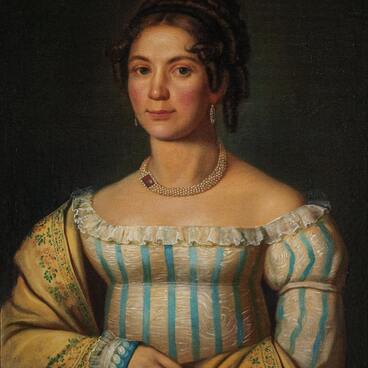The name of the artist who painted the portrait of Yelizaveta Musina-Pushkina is unknown, but after studying the details of the countess’s dress, art historians concluded that the portrait was painted in the early 19th century.
Most likely, the canvas was created by a provincial master not associated with the Academy of Arts. He focused not on conveying the emotional state or personality of the model but rather on realistic portraying and outlines of the accessories. This kind of Russian portrait is called manor. In such portraits, two styles are combined: the so-called insite, which results from the activity of an artist who has not received a systematic education, and Biedermeier, the “unsophisticated style”.
Biedermeier is considered the transition between neoclassicism and romanticism. Art critics are inclined not to even single it out as a separate style, but rather call it an art period in the peaceful time between the Napoleonic Wars and the European revolutions of the 1840s. The name to it was ascribed later, in the mid-1890s. Biedermeier is the modified name of the fictional comic character Gottlieb Biedermaier. His surname means “simple-minded Mr. Maier”. It became a symbol of the comfortable life of middle-class people, who prioritized everyday joys, holidays and hobbies.
The Biedermeier painting is characterized by attention to the costume and its details. In the portrait of Musina-Pushkina, the artist meticulously outlined a lace cap, a high collar of a dress, a pearl necklace, an order, and a light lace headscarf.
The inscription left on the back of the canvas speaks to the authenticity of the portrait. Before her marriage, Yelizaveta Musina-Pushkina was named Charlotte-Amalia-Isabella von Wartensleben. She married an acting privy councilor, Count Alexey Musin-Pushkin. He was the Russian ambassador to London, Stockholm and The Hague. He advocated the participation of Russian merchants in foreign trade relations, which at that time were controlled by foreign merchants. With his assistance, the famous collection of paintings by Robert Walpole was acquired for Catherine II, which enriched the collection of the Hermitage with paintings by Rubens, Van Dyck, Jordaens, Rembrandt, Poussin and other masters.
Most likely, the canvas was created by a provincial master not associated with the Academy of Arts. He focused not on conveying the emotional state or personality of the model but rather on realistic portraying and outlines of the accessories. This kind of Russian portrait is called manor. In such portraits, two styles are combined: the so-called insite, which results from the activity of an artist who has not received a systematic education, and Biedermeier, the “unsophisticated style”.
Biedermeier is considered the transition between neoclassicism and romanticism. Art critics are inclined not to even single it out as a separate style, but rather call it an art period in the peaceful time between the Napoleonic Wars and the European revolutions of the 1840s. The name to it was ascribed later, in the mid-1890s. Biedermeier is the modified name of the fictional comic character Gottlieb Biedermaier. His surname means “simple-minded Mr. Maier”. It became a symbol of the comfortable life of middle-class people, who prioritized everyday joys, holidays and hobbies.
The Biedermeier painting is characterized by attention to the costume and its details. In the portrait of Musina-Pushkina, the artist meticulously outlined a lace cap, a high collar of a dress, a pearl necklace, an order, and a light lace headscarf.
The inscription left on the back of the canvas speaks to the authenticity of the portrait. Before her marriage, Yelizaveta Musina-Pushkina was named Charlotte-Amalia-Isabella von Wartensleben. She married an acting privy councilor, Count Alexey Musin-Pushkin. He was the Russian ambassador to London, Stockholm and The Hague. He advocated the participation of Russian merchants in foreign trade relations, which at that time were controlled by foreign merchants. With his assistance, the famous collection of paintings by Robert Walpole was acquired for Catherine II, which enriched the collection of the Hermitage with paintings by Rubens, Van Dyck, Jordaens, Rembrandt, Poussin and other masters.



